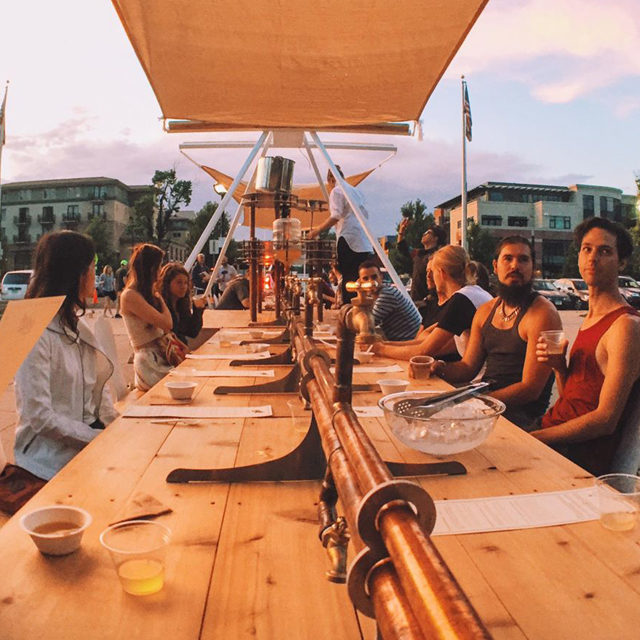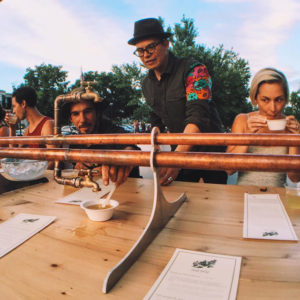
As temperatures rise and ecosystems change, many plants are in danger of rapid decline. In the foothills around Boulder, the osha plant, wild sarsaparilla and many different species of sedges are threatened by reduced moisture, hotter weather and other effects of climate change.
Artist Matthew Mazzotta used these Boulder County-specific plants in his travelling exhibit Harm to Table on Sept. 21. Mazzotta collaborated with local Boulder chefs, climate scientists and foodies to create a piece of public art to showcase food made with area-specific ingredients in danger of decline over the next 20-40 years.
Mazzotta is a conceptual artist who works to create community spaces for people to gather and interact as part of art, and with his travelling Harm to Table show, he hopes to spark conversation.
“That’s one thing that art can definitely do, is bring people into a conversation that they weren’t expecting to be a part of,” Mazzotta says.

To create Harm to Table, Mazzotta constructed a large, wooden table with tubs of wild sarsaparilla and sweetgrass soup and ponderosa osha kombucha in the center. Chocolate made with local bee pollen sat on plates in the center, and two pipes ran the length of the table, one dispensing the soup and the other dispensing the kombucha. Two long wings stretched out from the middle, with 14 total seats along the benches lining the length of each side. A cloth awning stretched over the entirety of the table, and at each end sat a musician, a cellist on one end and a saxophonist at the other.
Mazzotta chose the ingredients specifically after consulting with entomologists and climate scientists in Boulder, including Lynn Riedel, a plant ecologist at the City of Boulder’s Open Space and Mountain Parks. The organisms grow in the same ecosystem, which is in danger of decline as the Earth warms and drys.
Over the next several decades, the environment that sustains sedges, ponderosa pine, osha plant and wild sarsaparilla could be gone, making it very difficult for those species to survive.
“They’re here as remnants from the climates that we had 10,000 years ago and they found their refuges up here, in these cool, moist canyons, and those are the kinds of plants that will likely be in trouble if we are in a warming, drying trend,” Riedel says.
To add to the issue, bees survive off of these types of plants, so if the environment where these plants flourish is destroyed, bees will have a hard time finding food. “One of the big issues is decline in the species that create their food,” Riedel says.
The Harm to Table event was free, so people walking down Pearl Street had the chance to stop and eat while learning about the resources they were consuming. People would stop and ask volunteers, other Boulder residents and Mazzotta about the table.

Mazzotta’s art attempts to transform the public landscape through the use of social practice, an art form that focuses on the participatory efforts of individuals, communities and institutions to finalize the creation of a piece of art.
To start a project like Harm to Table, Mazzotta says he starts by talking directly to the people of the community to determine what problems they are facing. Then he comes up with an art piece that can make those issues tangible.
“Art can provide that platform, this third space, where people can actually have an authentic dialogue and let their curiosities be sparked, and then enter into a conversation with someone that they live with, but might not know,” Mazzotta says.

For example, in York, Alabama, he gathered information from the residents and determined they were sorely lacking in a permanent community space. To combat this, Mazzotta worked to design a small house-like structure that folds out into a 100-seat open air theater for the public to have a free gathering place, called Open House. Mazzotta used materials from the demolished remains of derelict buildings around York to create the structure.
For Harm to Table, Mazzotta relied on information from Riedel and climate scientists to formulate his ideas, met with local Boulder chefs to prepare the dishes with the specific ingredients and offered the foodie town of Boulder a good meal and an interesting conversation. Like Mazzotta’s other work, Harm to Table was community driven, and the environmentally conscious citizens of Boulder offered conversation and participation that shaped the overall composition of the piece.
“Many people sat and had conversations and got to have some meaning come from the project,” Mazzotta says. “So I think … this is a particular type of art that can be good for Boulder.”
Up next, Mazzotta’s “Open House” will be making an appearance in a show called “By The People” at Cooper Hewitt Smithsonian Design Museum in New York City.
HARM TO TABLE – Matthew Mazzotta
This table travels the country to serve food made of plants and natural resources of the local area that will be in major decline or extinct over the next 20-40 years due to the changing climate. Its focus is to directly translate the research of the world’s top climate scientists into an experience where you can actually eat the results of their work.














